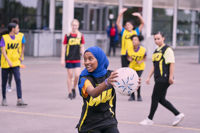
Discrimination and equality
A look at the legislation around discrimination and equality that sports bodies need to comply with
The UK has a wide-reaching legislative regime when it comes to discrimination and equality, including sports organisations. The European Convention on Human Rights (ECHR) is where much of the UK and European law in this area comes from, with the articles of the ECHR specifically relevant to sport being:
- Article 4 – prohibition of slavery and forced labour (the treatment of players and restrictions on transfers);
- Article 6 – right to a fair trial (a participant’s rights during disciplinary procedures and hearings);
- Article 8 – right to respect for private and family life (duty upon sports organisations to keep personal information on competitors protected and confidential);
- Article 9 – freedom of thought, conscience and religion (sports organisations to have an awareness of religious events like holy days when scheduling sporting events);
- Article 10 – freedom of expression (coverage by the press of off-field activities); and
- Article 11 – right to freedom of peaceful assembly and association (athletes seeking to organise themselves collectively so as to best protect their rights in some form of union).
The Equality Act 2010 incorporates all aspects of the UK’s obligations pursuant to the ECHR and EU law, and consolidates all the different laws and regulations in this area in UK law. The Equality Act 2010 is structured on two key tenets: the protected characteristics and the type of discrimination.
Protected characteristics and types of discrimination
The protected characteristics under the Equality Act are:
- age;
- disability;
- gender reassignment;
- marriage and civil partnership
- race;
- religion or belief;
- pregnancy and maternity
- sex; and
- sexual orientation
Discrimination occurs when a person treats, proposes to treat, or behaves in an unwanted way towards another person less favourably because they possess a particular characteristic as recognised in law, or perhaps because they have performed a protected act. A person may also be discriminated against because they associate with someone who has a particular attribute.
The board is required to ensure their organisation complies with the Act as the duty to avoid discrimination also extends to the provision of goods, services and facilities.
You should be conscious of avoiding several forms of discrimination under the Equality Act 2010:
- direct discrimination – one person treats another less favourably because of a protected characteristic
- indirect discrimination – treatment which may be neutral on its face but which discriminates in practice against members of a group who share a protected characteristic
- harassment – unwanted conduct towards a person which is related to a protected characteristic
- victimisation – a person is treated less favourably on the ground that they have done a protected act
You can be held liable under the Equality Act 2010 as an employer (with sports governing bodies being treated no differently than any other employer). You may also be liable as an organisation who can confer a relevant qualification (those who provide sports organisations who issue licenses to participate), employment services providers (e.g. vocational training) and service providers and associations. In addition, employers can be held vicariously liable for acts of discrimination by their employees to other employees. You therefore have a responsibility for your actions and the actions of employees, making training and education for all an important consideration for sport managers and boards.
Examples of discrimination
Disability discrimination occurs when a person with a disability is treated unfavourably because of something arising in consequence of their disability. Sports organisations, under s. 20 of the Equality Act, have a duty to make reasonable adjustments to service/programmes to accommodate persons with a disability. This must be applied equally to both participants and supporters.
Case study: Age discrimination
In Willey and Sharpe v England and Wales Cricket Board Limited, heard by a specialist employment tribunal, age discrimination claims were brought by two first-class cricket umpires who had been forced to retire by the England and Wales Cricket Board (ECB) upon becoming 65 years old. The tribunal began by stating that the two umpires were, because of their age, treated less favourably (in other words, sacked) than the ECB would treat someone of a different, lower age group. The less favourable treatment was the dismissal pursuant to their contracts.
The question was whether the ECB could convince the tribunal that in all the circumstances, their treatment was a proportionate means of achieving a legitimate aim.
The ECB put forward two allegedly legitimate aims: intergenerational fairness/succession planning (Aim One) and the preservation of dignity (Aim Two).
Importantly for the outcome of the case, the tribunal found that a compulsory retirement age was appropriate and reasonably necessary to pursue these aims. They made this founding principally on grounds of certainty and predictability, both for those already on the elite umpires list and those with aspirations to join it. Mr Willey and Mr Sharp were not able to advance less discriminatory ways of achieving the aim that would cause anything but ‘chaos’.
The tribunal also considered it significant that there were other routes available to the two of them to remain in the game (for example, as a mentor, match liaison officer or scorer) after being retired as an umpire.
The final issue that the tribunal had to be satisfied on regarding Aim One was whether the age of 65 was justified, given that it had been abolished by statute as being a compulsory retirement age. This was problematic for the tribunal, but they did, in the end, decide it was justified given the state pension age and legitimate expectations, among other things. The ruling on Aim One was determinative in the case and the umpires’ claim was dismissed.
Sex discrimination is the protected characteristic which has the most sport-specific amendments, including a statutory exemption under s. 195. An example of sex discrimination in sport was when the governing body of judo was ruled to have acted in a discriminatory manner by refusing to allow a qualified female to referee bouts between men. The Employment Tribunal added that it was not necessary for the female referee to show that her job prospects had been affected by the discriminatory conduct; it was sufficient that it was simply discriminatory in nature.
The s. 195 exemption allows sports clubs that are ‘associations’ under the Equality Act 2010 to organise separate sporting events for men and women if they choose to, where:
- physical strength, stamina or physique are major factors in determining success or failure; and
- one sex is generally at a disadvantage in comparison with another.
A further issue relevant to sports governing bodies when it comes to sexual discrimination is the topic of single-sex private sports clubs. These have attracted significant adverse publicity, in particular in golf. Guidance on the Equality Act indicated that member clubs may, in certain circumstances, restrict its membership to people who share a protected characteristic. This is not advisable or ethically defensible, and therefore not something an organisation should encourage.
Case study: Sexual orientation discrimination
Section 12 of the Equality Act 2010 applies to discrimination on the basis of sexual orientation. One important ruling which interpreted the law broadly emanated from another EU member state: Associtia Accept v Consiliul National Pentru Combaterea discriminarii. A Romanian football club was held liable for the homophobic remarks of one of its major shareholders about the possible transfer of a professional footballer, who it was alleged was homosexual, following a complaint by a non-governmental organisation that promotes and protects lesbian, gay, bisexual and transsexual rights in Romania.
Separate to claims under the Equality Act, a sports organisation should be aware of potentially discriminatory conduct by participants which must be provided for in regulations, policed and sanctioned. In recent years, there have been a number of high-profile examples of racial discrimination on the pitch in football, which the FA has had to deal with. These include alleged racial abuse from Luis Suarez to Patrice Evra and the use of the ‘quenelle’ anti-Semitic gesture by Nicolas Anelka. Another example of a high-profile case that led to a criminal investigation involved John Terry’s race-related scandal in 2011, when allegations were made that he had racially abused Anton Ferdinand on the pitch during a match.
These cases show how delicate an approach has to be taken by sports governing bodies when dealing with discrimination allegations, particularly those based on race. This becomes even more precarious when the police and criminal law are involved.
